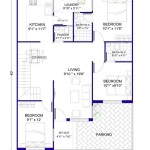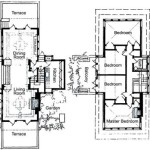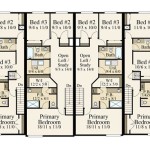How to Read Plans of a Building
Understanding building plans is an essential skill for architects, contractors, and anyone involved in the construction or renovation process. By learning how to read these plans, you can gain valuable insights into the design and layout of a building before any work begins.
Understanding the Basics
Building plans are typically drawn to scale, meaning that they represent the actual dimensions of the building. The plans will include various views of the building, including:
*Floor plans:
These show the layout of each floor, including the location of rooms, walls, windows, and doors. *Elevations:
These show the exterior and interior walls of the building from different perspectives. *Sections:
These cut through the building to show the interior structure, including the foundation, framing, and roof.Reading Floor Plans
Floor plans provide a bird's-eye view of the layout of each floor. To read a floor plan, follow these steps:
*Identify the scale:
Locate the scale indicated on the plan. This will help you determine the actual dimensions of the rooms and features. *Understand symbols:
Floor plans use symbols to represent different elements, such as walls, doors, windows, and fixtures. Familiarize yourself with these symbols to understand the layout clearly. *Measure the rooms:
Use the scale to determine the dimensions of each room. This will help you plan the placement of furniture, appliances, and other elements. *Note the circulation:
Pay attention to the flow of movement through the floor plan. Identify entryways, hallways, and staircases that connect different areas.Reading Elevations
Elevations show the exterior and interior walls of the building. To read an elevation, follow these steps:
*Identify the orientation:
Determine which side of the building is being shown. Elevations are usually labeled with the direction they face, such as "North Elevation" or "East Elevation." *Understand the scale:
As with floor plans, elevations are drawn to scale. Use the indicated scale to measure the heights and widths of different features. *Interpret the symbols:
Elevations use symbols to represent windows, doors, and other architectural details. Refer to the legend on the plan to understand these symbols.Reading Sections
Sections provide a cross-sectional view of the building, revealing its interior structure. To read a section, follow these steps:
*Identify the cutting plane:
Determine the line along which the building has been cut to create the section. This line is usually indicated on the plan. *Understand the scale:
Like other plan views, sections are drawn to scale. Use the indicated scale to measure the heights and thicknesses of different elements. *Interpret the layers:
Sections show the building's structure in layers, from the foundation to the roof. Identify the different materials and components used in each layer.Additional Tips
*Use a ruler or measuring tape:
This will help you accurately measure distances and dimensions on the plans. *Refer to the legend and notes:
These provide additional information about the building's design and construction. *Seek professional help if needed:
If you encounter any difficulties in understanding the plans, consult with an architect or contractor for clarification. By following these steps and tips, you can gain a solid understanding of building plans and use them effectively to plan and execute construction or renovation projects.
How To Read Architectural Plans Jda Lammin Architects

How To Read House Plans Floor Building In 10 Minutes Archid

An Architect Tells Us How To Read Floor Plans

Learn To Read Understand Construction Drawings Reading Site Plans Lesson 2

How To Read A Floor Plan Hensley Custom Building Group

How To Read Architectual Plans For Barndominiums Barndominium University E2

How To Read A Floor Plan

How To Read Architect S Drawings With Wikihow

How To Read Architect S Drawings With Wikihow

House Floor Plans Do You Know How To Read Them








